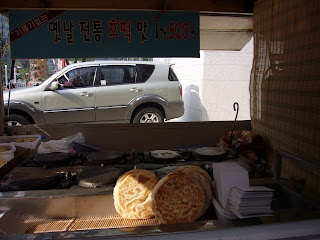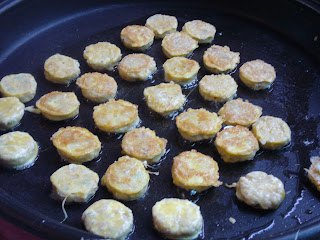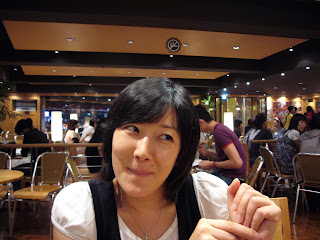Autumn and spring, I am told, are the most desirable seasons for a wedding. I learned this first hand last Saturday, when we attended two weddings! I remember watching the episode of
Gilmore Girls where Lane Kim gets married. In that episode, Lane's Korean relatives attended the brief ceremony, then in a hit and run fashion, handed in their monetary gifts, grabbed some galbi, and quickly went home. At that time, I didn't understand the joke, because in my experience, weddings are usually an all day affair. But, now, I totally get the origins of that gag.
Unless you're a mega celebrity with all sorts of entertainers singing and dancing at your wedding, Korean weddings are a relatively quick affair. After the ceremony, guests head to the reception for some lunch or dinner, then briefly greet the bride and groom, and then... they go home. Yes, that means no dancing; no garter belt or bouquet throwing; and no tapping of champagne glasses, forcing the couples to kiss.
I have not conducted any research, but I suspect that the brevity of Korean weddings are due to the high demands for space, particularly in Seoul. Autumn and spring equals big bucks for wedding halls, so these venues need to usher in the parties as quickly and efficiently as possible, and capitalize on their earning potential. I may be over generalizing, but this what I've gathered so far.
Another interesting contrast to Western customs is that couples in Korea issue their wedding invitations a week or two in advance of the ceremony. That's how we wrangled the invitation to a second wedding. In America, many couples agonize over the design of the invitation, the number of people they can afford to invite, and who is seated next to whom. Invitation procedures seem much more casual in Korea.
Before I describe my wedding experiences, I'd like to first make clear that I am quite ignorant about wedding traditions in Korea. (If you'd like to learn more about traditional Korean weddings,
this article looks interesting.) Most of what I'm about to describe is based on mere observation or what Hyeyoung has told me. I apologize in advance if either my video or narrative seems to be trivializing the ceremonies. That is not my intention at all. I am unfamiliar with all the customs and didn't understand most of what was said during the ceremony, so I'm just going to go ahead an interpret the ceremony, despite my ignorance. Okay? Let's begin!

The first wedding was held at
Sung Kyung Kwan University in
Daehagno. Over six hundred years old, this university for the natural and social sciences is built on historical grounds. Much of the traditional architecture is still in tact (though in dire need of renovation), which makes SKKU a popular spot for traditional weddings. We arrived at around 11 am to witness the nuptials of one of Cyndi's co-workers, a man that I know as Mr. Cute Devil (his words, not mine).
Upon arrival, we immediately headed towards a little tent where we turned in our white envelope containing a monetary gift for the bride and groom. This gift envelope entitled us to receive meal vouchers for the reception. I am told that some people hand in empty envelopes in exchange for a meal ticket. That is so terrible. You should at least stuff the envelope with some coupons. As it was a outdoor wedding, guests could choose to stand around or sit on the chairs.
A "traditional" wedding ceremony is symbolic of the gestures from the olden days, when weddings emphasized the joining of two families and involved several days of courtship and ceremony. Today, (or at least in the metropolitan areas) all of those customs are boiled down to under an hour. There were two gentlemen, garbed in mint green, who served as the officiant and MC of the wedding. Unfortunately, I could not understand most of what was said, so I can only tell you what appeared to be happening (with some extra notes from Hyeyoung).
First of all, the bride, escorted by four male attendants (employees of the venue), awaits in a little box. At the start of the ceremony, the bride (in her little box) is carried to a tent on the side, representing her family home. Then, the groom, carried on some sort of platform (arg! I can't think of the word), must follow the bride to her "home", symbolizing the tradition when the groom spent three days with the bride's family, after which, the bride must say goodbye to her family and forever live with her husband's family. Or, something like that. The groom is escorted by female relatives of both the bride and groom. Their affiliations are usually designated by a red or blue skirt, but in this particular wedding, all the relatives wore blue skirts. Unlike western weddings, none of the wedding party seemed to be maidens, or at least, they didn't look single.
After the little trek around the wedding grounds, the bride and groom are brought to the main tent, where the bride and groom are separated by a large table laden with all sorts of
dduk (rice cakes) and fruit. The bride and groom are not supposed to make eye contact at this time. I'm not sure what the significance of the food spread is, but all I know is, if I had to stare at a table full of snacks for thirty minutes at my wedding, I'd expect to have the freedom to snack on the food throughout the ceremony.
Across the table of food, the bride and groom alternate in a series of elegant bows. As Hyeyoung noted, the bride is made to bow twice, while the groom bows only once, thereby exerting his superior status.
Whatever. Following the bows, the bride and groom are each seated in front of a small table containing a gourd of wine. I read that the drinking of the wine symbolizes the unification of the bride and groom, but with my silly mind, I read the scene differently. I imagined that the the bride and groom were taking shots of soju in an effort to calm their nerves -- because that is the Korean way. My interpretation is way off base, but I'm sure that there are folks out there who wouldn't mind adopting such a custom. Right?
Following the booze, the couple are finally allowed to stand next to each other, though they still may not touch. Then, one of the men in green, launches into a lengthy lecture on love, marriage, family, loyalty, and respect -- or so I'm guessing. At some point during the speech, I think that the officiant pronounces them husband and wifey. Then the couple turns to the audience and bows. We all clap. Then... quickly bolt to the reception hall for the buffet!

Before I move on to the reception, some of you may be wondering what one wears to a Korean wedding. Fashion rules are quite lax. Most men wore suits or dress shirts, but the women came in a variety of outfits -- jeans and a blouse, semi-formal dress, or
hanbok. As long as you maintain the golden rule of all weddings -- Don't outshine the bride -- you can pretty much wear whatever you want. Interestingly, whereas Americans like to wear light colors to a wedding, black is quite popular at Korean weddings. There was a non-Korean man who wore a t-shirt, shorts, and sandals, but I don't think he was an official guest. He didn't seem to know anyone, and whipped out a fancy camera to capture the ceremony. I think he was there capturing fodder for his blog, which is fine, but the least he could have done was dress a little nicer in respect of the bride and groom.

Back to the reception... Cyndi, Hyeyoung, and I immediately hustled over to the banquet room so that we could find a good seat. To my surprise, the banquet room was almost half full. It looked like some people couldn't wait to get their grub on. The buffet featured an array of foods including sushi, lasagna, sandwiches, Chinese stir fry, a variety of soups, salad bar, and various Korean dishes. I enjoyed the variety of food, though, as it is with most buffets, quality was sacrificed at the cost of quantity. Once one has had your fill, people do not linger. They give their brief congratulations to the newlyweds, then head home, or as in our case, head to the next wedding.
We looked at the time, and it was only about 12:30 pm! Our next wedding wasn't until 3:00 pm, so we decided to look around the Sung Kyung Kwan University campus. Like most Korean universities, SKKU is located on a mountain, which means lots of uphill walking! The campus is lush and green, filled with lots of glinko trees. On our way through campus, I noticed a lot of banners. Hyeyoung explained that friends or fellow club members often create banners for folks who did really well on a big examine. For example, the yellow banner heralds the successful test results of two campus couples. I think this custom is so sweet. How cool would it be to see a banner on your way to school that recognizes your awesome MCAT scores?

After our tour around SKKU, we boarded a bus to
Yanjae for the second wedding. This western style ceremony was held in a wedding hall, a multi-storied facility solely dedicated to wedding ceremonies and reception. Typical of the hustle and bustle style that I'm learning to associated with Korea, wedding parties are scheduled back to back, with various parties flowing in and out of the wedding halls. When I entered the building it was quite chaotic. The lobby was filled with people from different wedding parties that it took us awhile to make certain that we were attending the right wedding.
We arrived a little early, so the groom informed us that the eating area was open, and that we could eat before the wedding if we were hungry. Eat
before the wedding ceremony? I've never heard of such a thing! We were still a bit full from the buffet, but after some deliberation, we decided, why not? This time around, we were met with a sit down meal featuring expensive 갈비 찜 (short rib stew) and 갈비 탕 (ox short rib soup). It was very tasty! Unfortunately, once we started eating, we lost track of time. Fortunately, there was a large projection screen that allowed us to observe the wedding as we continued to stuff our faces. Once we were done eating, we caught a ride with one of Cyndi's co-workers to Kangam so that we could watch
Bourne Ultimatum (which gets my two thumbs up). I felt a little odd about eating and running (even though I didn't really know the bride or groom), but I don't think anyone minded.
In America, wedding receptions are very group oriented. It's an opportunity for people to mingle, party, and collectively celebrate the nuptials of the bride and groom. Guests are an active participant in the wedding festivities. However, based on what I've observed (which may actually be atypical, for all I know), it seems that the wedding is primarily for the bride, groom, and their families. Guests are just incidental. Weddings are an opportunity to express your best wishes to the couple and an opportunity for a "free" meal.
We have a couple of more weddings coming up. Unlike the folks from the two weddings I just attended, I know the bride and/or groom a little better, so perhaps my understanding and perception of Korean weddings will evolve.
Check out the slide show for more photos. It's about five minutes long, so it will take a little longer than usual to load.


























































